Under-the-radar flies that will help you catch more fish in the spring creeks of the Driftless Area…
The Driftless is an amazing and unique fishery, and it arguably holds some of the most fascinating spring creeks in the world. Though standard trout flies catch their share of fish, a few unique patterns have sprung up from the special set of circumstances a spring creek brings a trout fisherman. A few guides, fly shop owners, and avid trout bums have graciously agreed to share some of their favorite trout patterns for the spring creeks of the Driftless Area. Some are standard trout patterns that have been tweaked for local waters, but most have been tied, tested, and developed specifically for the trout of the Driftless Area.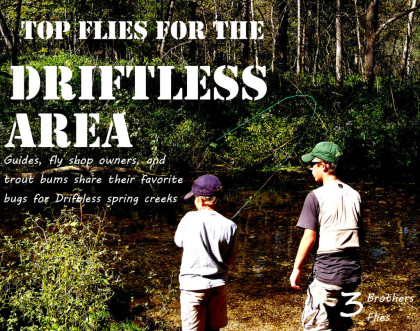
Dave Anderson, On the Fly Guide Service
Dave Anderson is a veteran guide on the streams and creeks of southeastern Minnesota’s Driftless Area. After guiding on local Driftless streams for over a decade, he has great knowledge of the bug life and the most productive flies on the area’s unique streams….
Really, most guys do not need a ton of flies in the Driftless to be successful outside of hatch specific patterns. Right now (August), I’m still fishing scuds, but it is a #14 with a very specific dubbing: ice dub and corgi fur.
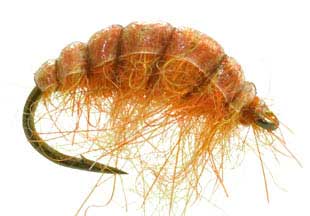
- Hook: TMC2487 or TMC2457 #14-16
- Thread: Orange 6/0 (8/0 on #16 and smaller)
- Tail: (optional) pearlescent or orange krystal flash strands, silver flashabou
- Dubbing: Orange or sulphur orange, gray, olive, pink/ Ice Dub UV Pink Shrimp
- Shell Back: Small piece of plastic to cover the dubbing or twisted krystal flash strands
- Ribbing: Fine copper wire
- Weight: Turns of .15 or .20 weight
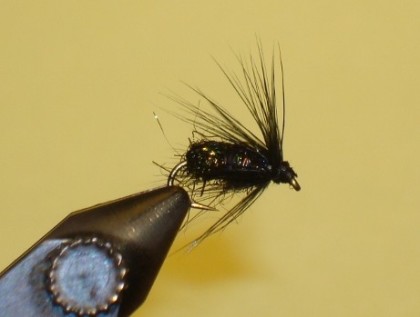
The Black Wet Fly is a pattern that lots of local guys fish this time of year (August). It’s a local pattern and probably isn’t well-known outside of the area.
- (Recipe by 3 Brothers Flies) Hook: #10-16 nymph
- Thread: Black 8/0 UNI
- Weight: A few wraps of lead free wire
- Shellback: A few strands of Krystal Flash
- Body: Black dubbing, dubbed to form a somewhat fat body
- Hackle: Black dry fly hackle
Driftless On the Fly
The guys over at Driftless On the Fly run a sweet operation guiding the waters of northeastern Iowa. Iowa is an often under-appreciated and overlooked fly fishing locale, but Jared Koenigsfeld and Ryan Rahmiller do an awesome job highlighting the great fly fishing opportunities found in Iowa on their website and blog. Here are a few of their best flies for the Driftless….
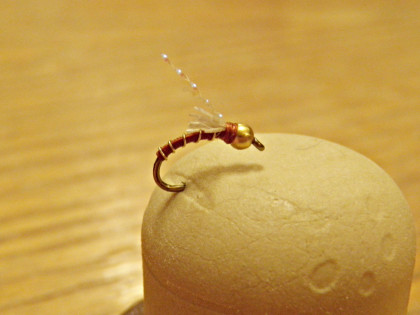
3$ Dip w/ UV Wing– The UV wing is what makes this guy special, almost any time of the day you can turn a fish with a midge and the added UV wing just gives it a little more flash like an air bubble on an emerging larva or wing. Top colors are Red, Rust, Black, and Olive and is sizes #16-22.
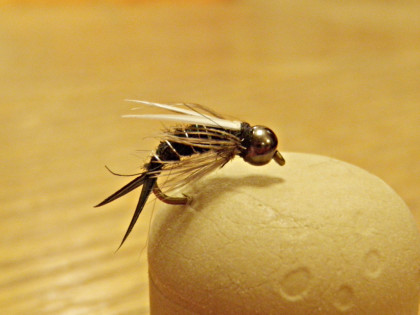
Prince of Darkness– We do have some stones in the Driftless of Iowa believe it or not, most of them are pretty small in the spring creeks. This fly just gives a new look to the standard Prince, black helps in dirty water situations. We use these especially in the Winter and Spring months, in sizes #14 & 16
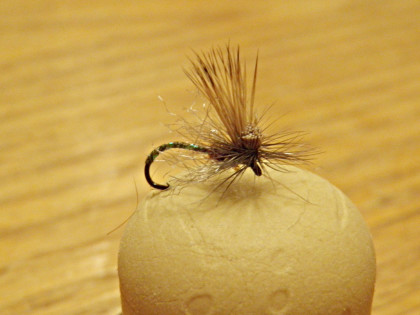
Missing Link Caddis – Great searching fly through the Spring to Fall months. Perfect for that solo riser along your favorite stream that you just can’t see what he’s eating, this fly has it ALL! From its spent look to its upright wing there’s just something buggy about this fly that really gets the fish up to the surface. Our favorite colors are Olive and Brown in sizes #14-18
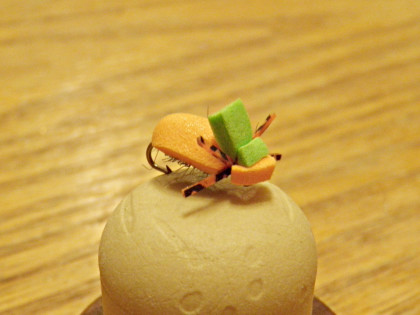
Indicator Beetle – Another great prospecting fly for the Summer and Fall months. Toss it along some high grassy banks in the peak heat of summer and you might be surprised to see the stream swallow your fly on impact. Works well as a dropper behind a hopper, solo, or even my favorite as a top fly with a real small nymph dropper, we prefer sizes #14 &16.
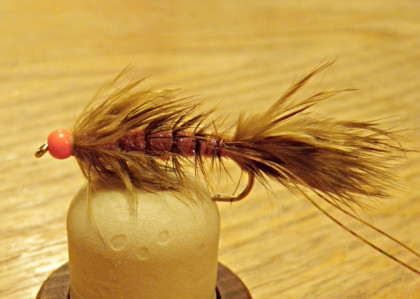
Hot-Bead Wooly Bugger – Its your standard Wooly Bugger but with a little twist, I never leave home with out these guys in my arsenal. In early Fall through late Spring, they can move some of your largest fish you have seen in your local water. Always vary your technique to key in on the action they are looking for, from low and slow to shallow and fast. Keep that a Florescent Orange bead and the body in black and brown, sizes #10-4.
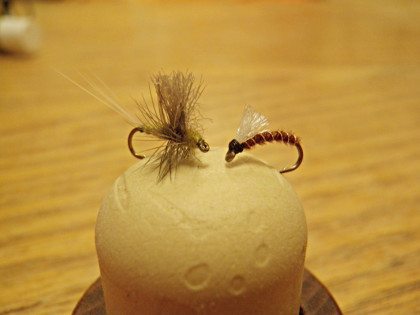
Guide Flies – Of course we use many standardized flies from day to day, which of most are what we call “Guide Flies”. The point being we want flies that are- simple yet effective, and that your able to tie 2 dozen in an hour or two without any difficulty before the next days trip. Keeping the same design, but a change in color or size allows us to do just that. Pictured here are Barr’s Vis-A-Dun in a Baetis, and a Shop-Vac.
Ben Carlson, Jolly Fly Fishing
An avid fly angler and trout bum, Ben Carlson has been fly fishing the streams of the Driftless Area since he was a young teen. He is the head guide at Jolly Fly Fishing, offering guided trips on his beloved home waters, the famous Rush and Kinnickinnic Rivers. His experience on these two popular western Wisconsin streams gives him a unique perspective on spring creek fly patterns, of which he shares a few thoughts and patterns here…
I am a big dry fly guy and being a spring creek fishermen I love and live for my mayfly hatches… so here are three of my favorites. They are all spin offs of generic patterns modified for my specific streams (primarily the Kinni and the Rush). A few notes about my flies in general… I never tie a traditional catskill style full hackle dry fly, it is always either a parachute or comparadun. In spring creeks there is not a lot of whitewater, which means that it it relatively flat and the trout can see pretty well (which makes our job hard). So tying a parachute or comparadun leaves the fly flush to the water and resembles a mayfly in its most vulnerable stage, fully emerged but unable to move yet as it’s wings still have to dry. One of my fly fishing mentors is a man by the name of David Halvorson, he is a retired Doctor and loves his BWOs, and his BWO pattern was featured in a fly tying magazine a few years ago… So the first pattern I’ll share is what I call Doc’s Parachute BWO.
Doc’s Parachute BWO
- Hook- 18-22 dry fly hook
- Thread – Olive
- Tail- Dun Colored Hackle Fibers
- Abdomen- Thread wraps (thicker near thorax)
- Wing Post- Mix of Dun and White Enrico Pulgisi Fibers
- Hackle- size 20 or 22 Dun or Grizzly Hackle
On flies this small, I do not dub them as it throws off the silhouette, instead I use thread wraps that get thicker near the thorax for the body. As with any dry, presentation and the right shape will outperform perfect colors. I love the BWO hatches because they can be quite prolific, especially if you hit the weather right. A cool, cloudy, and drizzly day makes these bugs come off with fury and the trout to rise to them, and this is usually the only pattern I throw to match this hatch. Another reason that the parachute works well is the trout are usually centered on the back eddies and slower moving parts of the pool, allowing this fly to sit perfectly on the water.
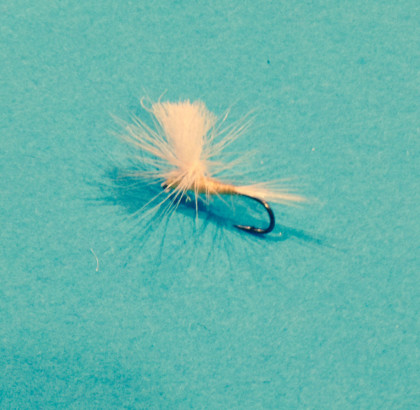
Granny Smith Comparadun PMD – My second fly is the Granny Smith Comparadun PMD
- Hook 16-20 Dry Fly Hook
- Thread – Chartreuse
- Tail- Anrton or Poly Yarn
- Body- Thread Wraps Thicker near Thorax
- Wing- Summer Deer Hair
I have heard them called PMDs, PEDs, Light Hendricksons, and Sulphurs, but they all fall under basically the same scientific classification. This hatch, which happens in the early evening in the earlier parts of the hatch but moves later and later with the season, can be absolutely crazy, as the color of the bugs can change. On the Kinni, the insects literally change color during the hatch starting out a light yellow and moving towards a light green (hence the name Granny Smith). The fish will be sensitive to this change and also to how it sits on the water. These comparduns are what the big fish in slow or flat water will take, so basically anything outside the main riffle. Be careful not to tie with too dark of a green and keep the wings a light color, anything too dark and it resembles a BWO and the fish won’t take it.
My last fly is a Trico pattern, and it’s really simple:
- Hook- Size 20-24 dry fly hook
- Thread- Black
- Body- Thread Wraps
- Wing Post- Poly Yarn
- Wing- Poly Yarn
- Tail- 2 or 3 Poly Yarn Fibers
This fly matches both the duns and spinners that you will find during a Trico hatch. Tie the wing post as you normally would but instead of tying hackle around it tie on another piece of poly yarn spinner wing style around the post. The tail is very minute, I have even left if off before and still caught fish. Starting in mid July, anytime the air temp hits 60 degrees these bugs come off and although tiny provide some great dry fly fishing if you are willing to wake up early enough!
Brian Smolinski (b smo), Lund’s Fly Shop
Brian J Smolinski (better known as b smo) is the owner of Lund’s Fly Shop, a full-service fly shop near the Rush and Kinnickinnic Rivers in River Falls, Wisconsin. He also ties some sweet streamers and tubes with materials from his fly tying company, Misfit fly co. As the owner of a local Driftless fly shop, Brian has a great pulse on the top-producing local fly patterns….
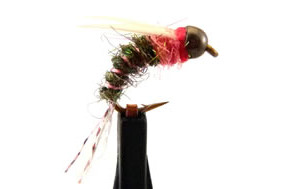
b smo’s Pink Princess – This fly was a custom order I got at the shop. This unnamed customer/friend asked me to come up with a fly that would be a combination of two very popular patterns that have been the most productive for them. The prince nymph and the hot pink squirrel. I decided that a dubbed body would be easier to create the desired profile, similar to the Lund’s Pink Squirrels. I love the peacock color of ice dub, but prefer to mix some rabbit hair in with all my ice dub to get a dubbing texture I like.
- Hook: TMC 2457, size 14
- Thread: UTC 70 Denier – Flo Pink
- Body: Blend of Ice Dub Peacock & Hare’s Ear Plus Dubbin Dark Olive
- Thorax: Blend of Hareline Dubbin Fluorescent Pink & Ice Dub Flo Shell Pink
- Bead: Tungsten 7/64″ Black Nickel
- Rib & Tail: Veevus Iridescent Pink
- Wing: White Goose Biots
One can hardly mention fly fishing in the Driftless without the infamous Pink Squirrel popping up. The Squirrel has attained a legendary, almost mythical status in the Driftless Area, spawning fish stories of ridiculous proportions and more than a few variations on the pattern. As Brian mentioned, Lund’s Pink Squirrel utilizes a curved scud hook, a short tail of Krystal Flash, and a two-toned dubbed body, notably using dubbing instead of chenille for the fly’s iconic pink hot spot. He also mentioned that Lund’s rendition appears to outsell the original three to one…
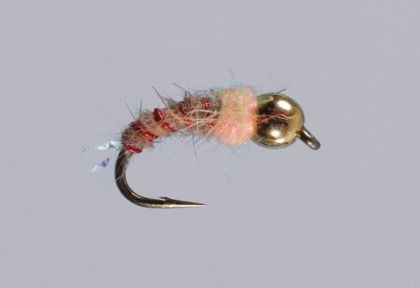
Lund’s Pink Squirrel – (Recipe by Brian J Smolinski)
- Hook: TMC 2457, size 12, 14, or 16
- Bead: Brass in appropriate size
- Thread: 8/0 in gray or tan
- Tail: Two strands of krystal flash
- Rib: Red wire
- Abdomen: Fox squirrel dubbing
- Thorax: A blend of shell pink & fluorescent shell pink dubbing
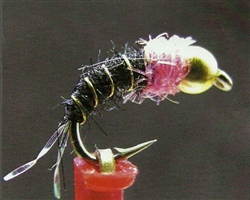
Lund’s HOT Pink Squirrel (Recipe by Brian J Smolinski)
- Hook: TMC 2457, size 12, 14, or 16
- Bead: Brass in appropriate size
- Thread: Black 8/0
- Tail: Two strands of krystal flash
- Rib: Gold wire
- Abdomen: Black squirrel dubbing
- Thorax: UV Fluorescent Hot Pink Ice Dub
Lund’s Pink Squirrel – I have lost track of how many times anglers have come into the shop and told me that they were getting skunked out on their favorite stretch of trout water, until they pulled out one of these beauties. They consistently seem to produce trout of all sizes on the Rush, Kinni, Trimbelle, and many other streams right around this area. With hundreds of new patterns coming out every year, this is a pattern that always seems to be a staple in our customer’s fly boxes. For the Lund’s HOT Pink Squirrel, use black dubbing for the abdomen, UV Fluorescent hot pink Ice Dub for the thorax, and gold wire for the rib. This varies from the original pattern tied by John Bethke. We’ve had these two versions custom-tied for us for a few years now and sold thousands of them. They continue to be one of the most productive nymphs for many anglers.
Nate and Jim Martin, Spirit Streams Fly Fishing
Focusing on the Driftless trout of Wisconsin, the Spirit Streams crew offers guided trips and some amazing posts on the Driftless over on their site and blog. Here are two of their most productive trout patterns…
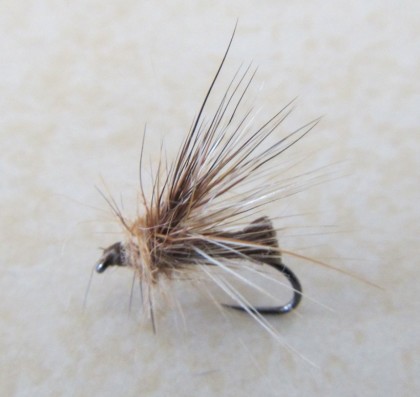
Coulee Crusader Caddis – The Coulee Crusader is a prolific trout-producing pattern throughout the year, but excels in May and June and in the evenings the remainder of the year. Adult Stonefly and Midge variants can be made with this pattern. Very productive.
- Hook: Mustad 94840 or equivalent, #16 and #18
- Wing: Coastal Deer, Natural
- Hackle: Barred Grizzly
- Dubbing: Brown, Green, Gray, Black
Notes: Tie in hackle parachute style, 3 turns. Dubbing pile at wing and direct hackles back toward hook bend.
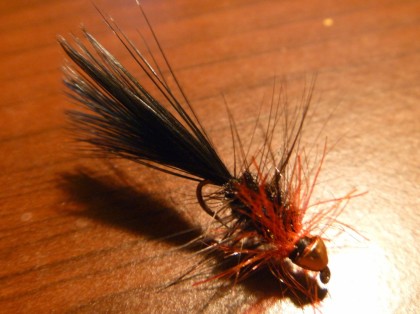
Red Storm – The Red Storm is a year-round lethal trout enticer. The pattern is based on the traditional Woolly Bugger but with a few key additions including the red collar. The red collar is the hot spot which attracts trout to the point of irresistibility. It is one of our crème de la crème fly patterns.
- Hook: Mustad 9672 or equivalent, #10 or #12
- Bead: Tungsten cone, gold, small
- Tail: Black Strung Marabou Feather
- Body: Chenille, small, black (it should have a sparkle to it)
- Hackle: Black Saddle Hackle Feather
- Collar: Red Crystal & Tri Lobal Fibers
———————————-
Standard nymphing and dry fly strategies are adequate for most creeks in the Driftless. Trailing a smaller, more imitative nymph (such as a Shop Vac or $3 Dip) behind a more gaudy attractor fly (Pink Squirrels, Black Wet Flies, scuds) is an especially deadly tactic. Dry-dropper rigs are another great strategy, particularly in the summer months when the terrestrials are out in force. We’ve also found that Driftless fish are particularly susceptible to some slight movement or jigging action worked into the drift.
This is a great selection of bugs that will serve an angler well throughout the entire season. All these patterns are well suited to the conditions that the small, fertile trout streams of the Driftless bring to the angler and will take plenty of trout on the local spring creeks.
Tie up a few of these bugs and toss them on the local trout streams this season. You won’t be disappointed!

